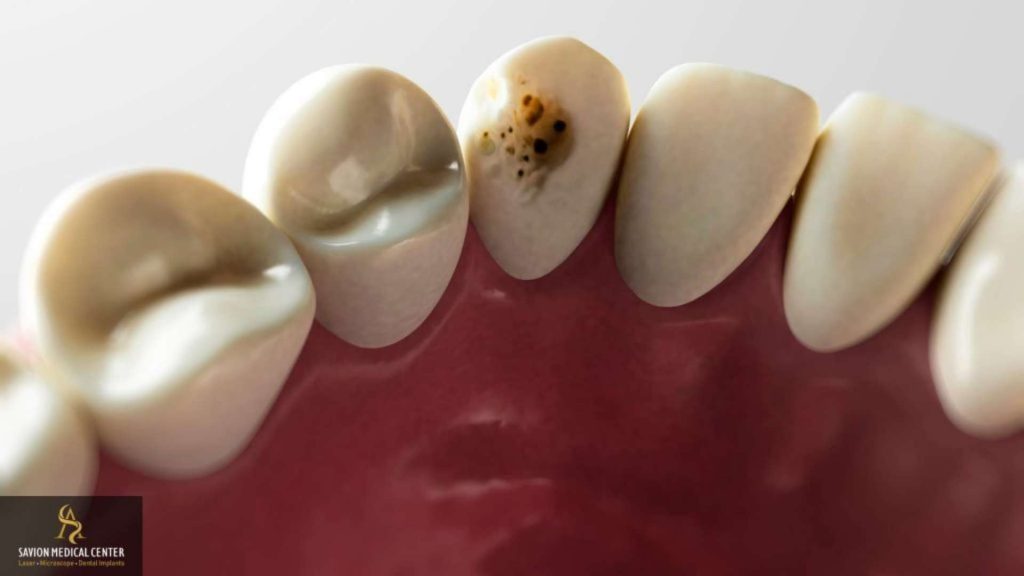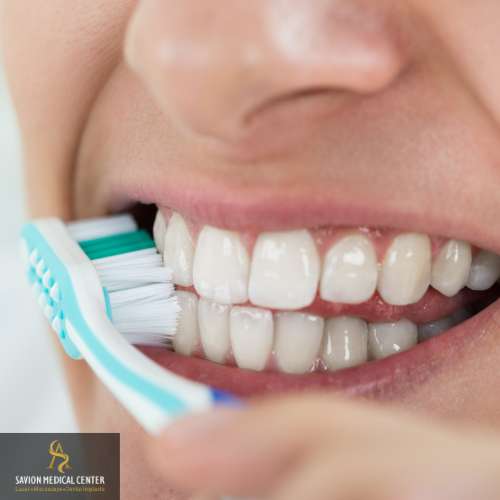Dental Cavities, Causes and Development
Dental cavities are characterized by damage and destruction of tooth enamel. This enamel destruction results from acidic secretions produced by bacterial activity. Cavity-causing bacteria feed on sugars residing on teeth, secreting acid that attacks the hard outer layer.
In the early stages of cavity formation, enamel begins deteriorating, and if left untreated, the cavity progresses to the underlying dentin layer. If the disease remains untreated, cavities can penetrate even deeper, reaching the pulp layer.
Cavities result from poor oral hygiene combined with consumption of sugar-rich and carbohydrate-heavy foods. Sometimes reduced saliva production contributes (saliva plays a crucial role in maintaining natural oral hygiene). Simply put, cavities represent what we call "tooth decay" or "holes in teeth." When we consume sugar-rich foods, particularly sweets, but also breads, baked goods, and sugary beverages, we're feeding cavity-causing bacteria their favorite food.
Acid secretion contributes to plaque formation. Without diligent teeth cleaning, plaque and acid gradually erode teeth. Therefore, remember that consistent brushing and regular dental checkups will help prevent cavities or treat them at the earliest possible stage.
Dr. Ariel Savyon
Dentist since 2007, holds a double master's degree (Germany) in laser science and implantology (dental implants).
Serves as medical director of the dental corporation "Savyon Medical Center Ltd. Owner of a prestigious study club master_implant, treating dentists in various fields. The only certified instructor in Israel of the World Clinical Laser Institute in the field of laser science in dentistry in Israel.
Dr. Savyon, an opinion leader for leading companies in Israel and around the world, a researcher and international lecturer in the field of laser dentistry, periodontal medicine, and dental implants.

The Risks of Untreated Cavities
Untreated dental cavities can lead to severe dental problems and additional diseases. The primary risks worth noting include:
As cavities spread and penetrate deeper into the tooth, they can cause pain and sensitivity in the affected tooth. When decay reaches the inner tooth layer (containing nerves and blood vessels), it can become extremely painful.
Without prompt dental treatment, the situation may worsen to the point where a regular filling cannot address the cavity, requiring root canal treatment instead. In certain cases, delayed treatment may necessitate extraction. Therefore, obtaining early treatment is essential.
Long-term untreated cavities can cause local infections. In some cases, infections may worsen until an abscess forms. Alongside severe pain and swelling, patients in such situations may experience fever and general malaise.
This can lead to abscess formation, a pus-filled pocket developing around the infected tooth. As with any infection, urgent treatment is critical. Untreated infections can spread throughout the body, creating significant health risks.
Long-term oral health neglect can cause various medical problems. Medical research has discovered connections between oral infections and cavities with worsening heart disease, diabetes, stroke, and more.
Additionally, people suffering from tooth pain may struggle to eat and experience significant quality of life decline. Therefore, the conclusion is clear: don't neglect dental health, visit the dental clinic for treatment promptly.
How Are Cavities Diagnosed at Our Dental Clinic?
Modern dentistry has greatly improved the ability to diagnose cavities even in very early stages. Experienced dentists can identify various spots on tooth surfaces indicating cavity formation.
Thanks to improved X-ray imaging technology and microscope use, decay can be detected before becoming noticeable or visible to the naked eye. Precise imaging enables identification of hidden cavities, for example, between teeth or beneath existing fillings.
Technology exists that detects tooth tissue breakdown processes at very early stages. Detection occurs using lasers and examination equipment that scans internal tooth structure.
This technology works to patients' advantage, which is certainly encouraging.
Laser scanning devices are now considered particularly effective in detecting hidden cavity decay. Techniques provide detailed images of tooth structure while identifying cavity signs invisible even on traditional X-rays. The result is optimal treatment provided on time, less invasive procedures, tooth tissue preservation, and minimized intervention.

Cavity Symptoms and Warning Signs
Common cavity symptoms include:
- Tooth pain, The pain may be persistent and constant, or it may come in waves or sharp intermittent episodes. Often, pain worsens when eating sweets or consuming very hot or cold beverages.
- In advanced cavity cases, holes appear on the diseased tooth that dentists may notice with the naked eye. These holes are essentially points where enamel has been damaged and destroyed, replaced by empty cavities (which must be filled to prevent additional damage and preserve the tooth).
- Tooth stains can be preliminary cavity indicators. They may appear as white spots, and if untreated, these spots may change color and become darker.
Beyond these common symptoms, cavities may also cause additional signs, such as bad breath or unpleasant taste in the mouth. In advanced disease stages, swelling may appear in gums adjacent to the affected tooth.

Treatment Approaches for Dental Cavities
The nature of cavity treatment depends on damage severity and disease stage when seeking dental care.
- In Early Stages, Fluoride treatments can be effective. This mineral may enable enamel repair when damage is minimal.
- If Cavities Have Progressed and Actual Holes Have Formed, Fillings are typically required. The dentist removes decayed tooth material, then performs a filling that can be silver or white (composite).
- If Cavities Are Deep, Root Canal Treatment Becomes Necessary. This means removing part of the tooth pulp, cleaning root canals, and sealing them to prevent infection recurrence.
- If the Tooth Is Severely Damaged, Continued Treatment May Include Crown and Build-Up, preventing tooth collapse while maintaining as natural an appearance as possible.
- In Cases Where a Diseased Tooth Cannot Be Saved, Extraction May Be Necessary to prevent pain and cavity spread to adjacent teeth. Following extraction, dental implants can be performed to maintain chewing ability and prevent bone resorption in the jaw and surrounding area.
Cavity Prevention Tips
The best way to address cavities is preventing them. Use these helpful tips:

Tooth Brushing
Brush teeth twice daily. Replace toothbrushes on time and preferably use dental floss.

Healthy Dietary Habits
Minimize sweets and sugary beverage consumption. Maintain balanced nutrition including hard foods that help naturally remove plaque and bacteria from teeth.

Dental Sealants
Dental sealing essentially coats teeth, especially those difficult to reach through routine brushing.

Regular Checkups
Attend regular dental examinations even without experiencing pain or other symptoms. Regular visits combined with tartar cleaning as needed help preserve your teeth.
Dental Laser Cavity Treatment
Laser cavity treatment differs in several ways from traditional cavity treatments. Traditional treatments use mechanical drills removing damaged tooth material. Laser treatment, conversely, removes diseased tooth tissue using highly focused energy.
This eliminates noisy, unpleasant drilling while enabling precise removal of only diseased tooth layers. Unlike traditional treatments performed under local anesthesia, laser treatments are far less painful, often eliminating the need for anesthetic injections or allowing milder anesthesia methods.
Advantages of Laser Treatment Versus Traditional Cavity Treatment (with Drill):
Optimal Precision and Tooth Structure Preservation
Considered Far Less Invasive
Reduced Discomfort and Rapid Recovery
Noise Free Treatment Experience
Tooth Restoration Without Root Canals and Crowns
More Conservative Treatment
Painless and Much More Comfortable and Natural for Patients
Erbium Lasers in Dentistry Generally and Cavities Specifically
Erbium lasers have become the standard for dental treatments at the highest and most advanced levels. These lasers emit light at wavelengths absorbed (received) effectively by water molecules and hard tissues treated in teeth diseased with cavities.
This fact enables highly efficient removal of diseased tissue affected by cavities without harming adjacent hard tissues in the treated tooth.
These are some treatments performed using erbium lasers in dentistry:
Gum Treatment and Shaping
Erbium lasers can also remove diseased gum tissue and improve gum shaping when treating gum recession or bacterial pockets (periodontal pockets).
Treating Tooth Sensitivity
This laser type can be used in root canal treatments, root planing, and other tooth sensitivity conditions resulting from gum recession.
Aesthetic Design Alongside Restorative Treatments
Additionally, erbium lasers can serve as aesthetic design alongside restorative treatments, such as crown lengthening procedures and dental implantations.
Treating Cavities and Decay
Erbium lasers can remove infected tooth portions completely, precisely, and without drilling.
Good to know! How Lasers Work in Cavity Treatment and Decay
Even without delving into the full scientific depth of medical lasers, it's worth knowing that lasers operate through what can be called "tissue ablation." A mechanical effect occurs primarily when short pulses of high-intensity laser radiation strike tissue.
When this high energy amount impacts a concentrated area, immediate but focused tissue heating occurs. Because heating occurs extremely rapidly (faster than the time needed for tissue to expand from heating), a "shockwave" effect is created. You can visualize this as a controlled explosion designed to remove only affected and diseased areas in the structure.
To summarize:
- Laser treatments excel at maximum precision
- Additional sterilization occurs in the treated area through the laser beam
- Such treatments can even be performed without anesthesia (in some cases), without pain sensation or discomfort
- Treatment doesn't create vibrations, so tooth structure doesn't crack or suffer peripheral damage
- No noise, exceptionally quiet treatment, suitable even for those with dental anxiety and patients of all ages


















